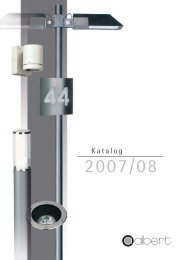2008 2009 das richtige licht für die feine arbeitswelt ... - MP-Leuchten
2008 2009 das richtige licht für die feine arbeitswelt ... - MP-Leuchten
2008 2009 das richtige licht für die feine arbeitswelt ... - MP-Leuchten
You also want an ePaper? Increase the reach of your titles
YUMPU automatically turns print PDFs into web optimized ePapers that Google loves.
PERFECT LIGHTING, BOTH FOR YOU AND THE ENVIRONMENT<br />
Filament bulbs 12 V IRC halogen bulbs Energy-saving bulbs<br />
Are energy-saving bulbs an effective<br />
substitute for filament bulbs?<br />
The good old filament bulb has in<br />
recent years been criticised as an<br />
energy waster. Due to its excellent<br />
colour rendering index of Ra* =<br />
100, it is, however, the first choice<br />
when it comes to enhancing the<br />
ambience and the sense of wellbeing.<br />
On account of the perceivably<br />
poorer colour rendering index of<br />
Ra* = 80, the much-lauded<br />
energy-saving bulbs or compact<br />
fluorescent bulbs are, at best, an<br />
effective substitute in areas in<br />
which a lot of time is spent or<br />
where saving energy is more important<br />
than the colour rendering - e.g. in<br />
hallways, staircases or storerooms.<br />
* As is the case for daylight, artificial<br />
light should also enable as an<br />
accurate as possible perception of<br />
colours. The benchmark for this is<br />
the colour rendering properties of a<br />
light source which are described<br />
with the colour rendering index<br />
Relative energy consumption in comparison with filament bulbs<br />
100 %<br />
80%<br />
60%<br />
40 %<br />
20%<br />
0%<br />
20 bruck.de<br />
Filament bulbs<br />
100%<br />
100%<br />
100 W<br />
75 W<br />
Atmospheric light and energy<br />
saving - is that possible?<br />
With a colour rendering index of<br />
Ra* = 100, halogen bulbs emit<br />
colours of the same quality as<br />
filament bulbs. 12 V halogen bulbs<br />
with an infrared coating on the<br />
bulbs (IRC technology) coupled<br />
with an electronic transformer also<br />
result in savings in energy of more<br />
than 40% in comparison with<br />
traditional filament bulbs. With a<br />
service life of 4,000 hours, these<br />
bulbs also last four times longer.<br />
Ideal for high class conference<br />
tables and elegant workstations.<br />
Thus, you can save energy<br />
without having to compromise<br />
on ambience.<br />
"Ra". This index is between 0 and<br />
100. The higher the index, the<br />
better the colour rendering; 100 is<br />
the optimum index.<br />
230 Vhalogen<br />
bulbs<br />
100%<br />
80%<br />
100 W<br />
60 W<br />
12 Vhalogen<br />
bulbs<br />
81%<br />
72%<br />
75 W + 6 W*<br />
50 W + 4 W*<br />
When should I use energy-saving<br />
bulbs?<br />
Energy-saving bulbs consume<br />
approximately 20% of the energy<br />
of a standard filament bulb and last<br />
ten times longer. Energy-saving<br />
bulbs have a colour rending index<br />
of Ra*=80.<br />
These bulbs are suitable for areas<br />
where lights are on for long periods<br />
of time but where not much time<br />
is actually spent, such as hallways<br />
and staircases.<br />
12 V IRC<br />
halogen bulbs<br />
58%<br />
56%<br />
IRC<br />
ENERGY SAVER<br />
50 W + 4 W*<br />
35 W + 4 W*<br />
Energy-saving<br />
bulbs<br />
20%<br />
20%<br />
20 W<br />
15 W<br />
LED<br />
Do LEDs save energy without<br />
compromising on ambience?<br />
LEDs are undergoing a highly<br />
dynamic development. Today, they<br />
already achieve up to 100 lm / W<br />
and are therefore one of the most<br />
economic light sources.<br />
Due to the efficient light projection<br />
and very few scattering losses,<br />
remarkable brightness with little<br />
energy has now been achieved.<br />
LEDs are extremely small and can<br />
be integrated into many locations<br />
where traditional light sources<br />
prove too large, e.g. onto beds as a<br />
reading light or in display cabinets<br />
to show off valuable objects.<br />
Coloured LEDs are ideal for<br />
fascinating effects, such as in<br />
illuminated ceilings and walls as<br />
well as on furniture and in coves.<br />
White LEDs in a warm tone design<br />
are currently available with a<br />
colour rendering index of Ra*=80.<br />
They are therefore only recommended<br />
for areas in which very good colour<br />
rendering is required, such as<br />
for illuminating colour pictures.<br />
LED light is particularly well<br />
suited for reading books. Use LEDs<br />
specifically for providing<br />
sophisticated light in selected<br />
areas, and thus save energy.<br />
The standard filament bulb<br />
(100%) is compared with<br />
bulbs with a comparable<br />
luminous flux (± 12%).<br />
*incl. power loss of a standard<br />
electronic transformer







